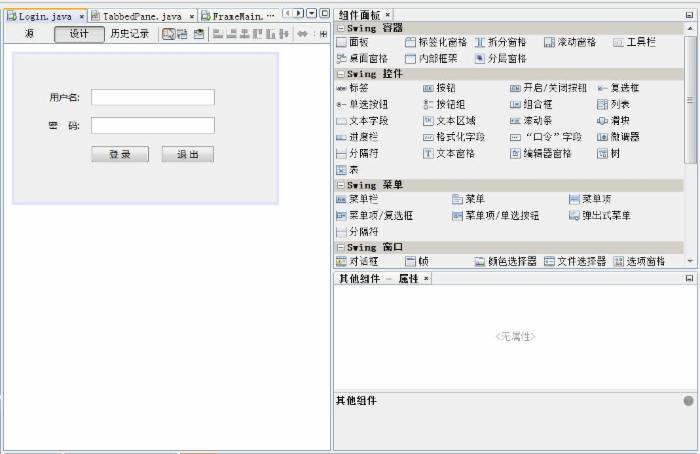Java Swing快速构建窗体应用程序
1 应用结构 新建一个java应用程序JavaApp,并创建相关的包及文件,其中简单实现了一个登录界面(JDBC 访问MYSQL数据库),登录成功后跳转到主界面.在主界面上单击菜单,可以打开子窗体.java swing自带的JTabbedPane没有显示关闭按钮的功能,这里在com.mkmis.controls包下自定义了一个TabbedPane控件,可以实现带关闭按钮的页签面板.应用结构如下图所示:

2 登陆界面设计 在IDE中新建一个Login的JFrame窗体,单击[设计]视图,可以将组件面板中的相关控件拖放到界面上,和Vistual Studio的操作差别不大,是界面显示效果较差,不及Vistual Studio.用户名文本框用的文本字段,密码框用的是口令字段控件.登录和退出按钮用的是按钮控件. 设计完成后,单击运行按钮,界面效果如下图所示:

3 相关属性设置 Java Swing的很多属性设置用的方法,而NET用的属性.例如设置窗体标题,java swing用的是setTitle().另外窗体居中用的是setLocationRelativeTo(getOwner()). 获取文本框的值为getText()方法,如下代码所示: 1 public Login() { 2 initComponents(); 3 setTitle("登录"); 4 setDefaultCloseOperation(EXIT_ON_CLOSE); 5 setVisible(true); 6 setResizable(false); 7 setLocationRelativeTo(getOwner()); //居中显示 8 9 } 1 private void btnLoginActionPerformed(java.awt.event.ActionEvent evt) { 2 // TODO add your handling code here: 3 if(this.txtUserName.getText()!="" && this.txtPWD.getText().toString()!="") 4 { 5 Connection conn = DBConnection.getConnection(); 6 PreparedStatement ps = null; 7 ResultSet rs = null; 8 try { 9 ps = conn.prepareStatement( "select * from users where UserName = ? and password = ?"); 10 ps.setString(1,this.txtUserName.getText());// 11 ps.setString(2, this.txtPWD.getText()); 12 rs = ps.executeQuery(); 13 while (rs.next()) { 14 User user = new User(); 15 user.setId(rs.getInt("id")); 16 user.setUsername(rs.getString("UserName")); 17 user.setPassword(rs.getString("password")); 18 19 System.out.println(user.toString()); 20 //跳转页面 21 FrameMain frm=new FrameMain(user.getUsername()); 22 frm.setVisible(true); 23 this.dispose();//关闭当前窗体 24 25 } 26 } catch (SQLException e) { 27 e.printStackTrace(); 28 } finally { 29 DBConnection.closeResultSet(rs); 30 DBConnection.closeStatement(ps); 31 DBConnection.closeConnection(conn); 32 } 33 34 } 35 } 显示一个窗体是设置其setVisiable(true);关闭一个窗体用的dispose();在登录界面想着输完用户名和密码后,按enter键可以自动登录,在网上搜下,发现了一个变通的方法,是监听密码框的keypressed事件,当然需要验证一下用户名和密码是否为空(此处未加验证!),如下代码所示: 1 private void txtPWDKeyPressed(java.awt.event.KeyEvent evt) { 2 // TODO add your handling code here: 3 if(evt.getKeyCode()==KeyEvent.VK_ENTER) 4 { 5 //调用登录事件 6 btnLoginActionPerformed(null); 7 8 } 9 } 4 主界面 登录成功后,单击左边的树叶节点,通过反射动态实例化窗体(实际上菜单应该从数据库加载)并显示,主界面如下: 图表控件用的是JFreeChart控件,默认显示中文有乱码情况,需要设置显示中文处的字体进行解决.另外设置主界面显示大化的代码为this.setExtendedState(this.getExtendedState()|JFrame.MAXMIZED_BOTH).为了让某个控件可以随着窗体大小变化而自动调整,需要设置其水平和垂直自动调整. 1 public FrameMain(){ 2 initComponents(); 3 setLocationRelativeTo(getOwner()); //居中显示 4 this.setExtendedState(this.getExtendedState()|JFrame.MAXIMIZED_BOTH ); //大化 window 5 LoadTree(); 6 7 } 8 public FrameMain(String uname){ 9 initComponents(); 10 setLocationRelativeTo(getOwner()); //居中显示 11 this.setExtendedState(this.getExtendedState()|JFrame.MAXIMIZED_BOTH ); 12 LoadTree(); 13 this.lblUser.setText("欢迎 "+uname+ " 登录!"); 14 15 } 主界面在初始化时,调用LoadTree方法来填充左边的菜单树,如下所示: 1 private void LoadTree() 2 { 3 //自定义控件,支持关闭按钮 4 jTabbedPane1.setCloseButtonEnabled(true); 5 6 DefaultMutableTreeNode node1 = new DefaultMutableTreeNode("软件部"); 7 node1.add(new DefaultMutableTreeNode("产品部")); 8 node1.add(new DefaultMutableTreeNode("测试部")); 9 node1.add(new DefaultMutableTreeNode("设计部")); 10 11 DefaultMutableTreeNode node2 = new DefaultMutableTreeNode("销售部"); 12 node2.add(new DefaultMutableTreeNode("jack")); 13 node2.add(new DefaultMutableTreeNode("Lily")); 14 node2.add(new DefaultMutableTreeNode("Smith")); 15 16 DefaultMutableTreeNode top = new DefaultMutableTreeNode("职员管理"); 17 18 19 top.add(new DefaultMutableTreeNode("总经理")); 20 top.add(node1); 21 top.add(node2); 22 23 //JTree tree=new JTree(top); 24 DefaultTreeModel model = new DefaultTreeModel (top); 25 this.jTree1.setModel(model); 26 //jTree1.getSelectionModel().setSelectionMode(TreeSelectionModel.SINGLE_TREE_SELECTION) 27 //set jframe icon 28 try 29 30 { 31 Image icon= ImageIO.read(this.getClass().getResource("/images/Icon.png")); 32 tabIcon = createImageIcon("/images/Icon.png", "tab icon"); 33 34 this.setIconImage(icon); 35 } 36 catch(IOException ex) 37 { 38 39 System.out.println(ex); 40 41 } 42 43 } 在Tree的值变化事件中,通过class.forName()和 cls.newInstance()反射动态实例化窗体,代码如下: 1 private void jTree1ValueChanged(javax.swing.event.TreeSelectionEvent evt) { 2 // TODO add your handling code here: 3 4 DefaultMutableTreeNode node = (DefaultMutableTreeNode) jTree1.getLastSelectedPathComponent(); 5 6 if (node == null){ 7 //Nothing is selected. 8 return; 9 } 10 11 Object nodeInfo = node.getUserObject(); 12 String item = (String) nodeInfo; 13 14 if (node.isLeaf()) { 15 String item1 = (String) nodeInfo; 16 // this.setTitle(item1); 17 //File f = new File("client.jar"); 18 //URLClassLoader cl = new URLClassLoader(new URL[]{f.toURI().toURL(), null}); 19 //Class<?> clazz = cl.loadClass("epicurus.Client"); 20 //Method main = clazz.getMethod("main", String[].class); 21 //main.invoke(null, new Object[]{new String[]{}}); 22 try { 23 Class cls = Class.forName("com.mkmis.forms.JIFrame1"); 24 javax.swing.JInternalFrame frm = (javax.swing.JInternalFrame) cls.newInstance(); 25 frm.setVisible(true); 26 27 //jTabbedPane1.addTab(" "+item1+" ",null,frm); 28 jTabbedPane1.addTab(" "+item1+" ",this.tabIcon,frm); 29 30 } 31 catch (Throwable e) { 32 System.err.println(e); 33 } 34 } else { 35 System.out.println("not leaf"); 36 } 37 } 在javaswing中的路径也和net不同,下面定义了一个创建ImageIcon的方法: 1 /** Returns an ImageIcon, or null if the path was invalid. */ 2 protected ImageIcon createImageIcon(String path,String description) { 3 java.net.URL imgURL = getClass().getResource(path); 4 if (imgURL != null) { 5 return new ImageIcon(imgURL, description); 6 } else { 7 System.err.println("Couldn't find file: " + path); 8 return null; 9 } 10 }